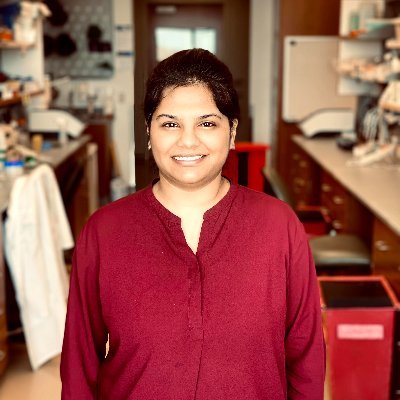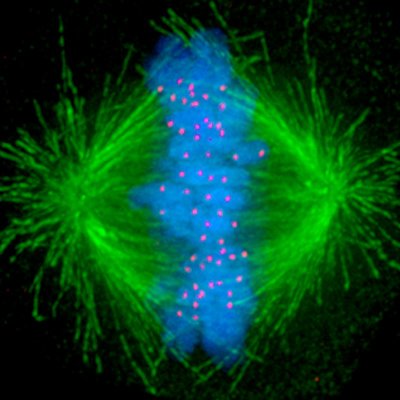
Steph Sansbury
@stephsansbury
Followers
137
Following
196
Media
6
Statuses
69
Postdoc in the Baker lab at the Institute for Protein Design. Trying to figure out how to get things into cells.
Seattle, WA
Joined September 2014
I am excited to announce the release of our BioRxiv preprint: “Network-aware self-supervised learning enables high-content phenotypic screening for genetic modifiers of neuronal activity dynamics”. 1/ https://t.co/eeo4SoMMI4
biorxiv.org
High-throughput phenotypic screening has historically relied on manually selected features, limiting our ability to capture complex cellular processes, particularly neuronal activity dynamics. While...
1
6
23
Excited to share our work on alpha-synuclein and N-terminal acetylation led by talented and recently graduated @Saranya_S_Kumar out in @ScienceAdvances! With vital contributions from Nima Naseri and @LaserSharkLab, check out thread below!
🎉Thrilled to announce my first, first-author paper in @ScienceAdvances! 📝Delved into alpha-synuclein biology using CRISPR screens, unveiling new insights and potential therapeutic targets for #Parkinson. 🧬 https://t.co/yQZ76Hbw4h
5
14
67
🎉Thrilled to announce my first, first-author paper in @ScienceAdvances! 📝Delved into alpha-synuclein biology using CRISPR screens, unveiling new insights and potential therapeutic targets for #Parkinson. 🧬 https://t.co/yQZ76Hbw4h
science.org
Pooled CRISPR screens expose potential therapeutic strategies to lower alpha-synuclein in human neurons.
3
8
59
My brilliant, creative, unstoppable friend did very cool work toward even more powerful CART cell therapies:
Excited to share my Ph.D. work in @carlhjune lab showing uninhibited CD28 co-stimulation via CTLA4 disruption invigorates dysfunctional CART cells https://t.co/vTZJzH3IST
0
1
5
Interested in chemical biology? PTMs? Protein Degradation? Proteomics? We're recruiting postdocs! If you're interested in developing new chemical biology technologies then please reach out! https://t.co/aXBzlHUIng
#chempostdoc
burslemlab.com
3
66
98
Our platform for rapid manipulation of endogenous proteins at scale #SPOTLITES can be employed to discover novel effectors for #targetedproteindegradation #TPD and other proximity-based approaches! https://t.co/hcdjiFFKYw
biorxiv.org
The field of induced proximity therapeutics is in its ascendancy but is limited by a lack of scalable tools to systematically explore effector-target protein pairs in an unbiased manner. Here, we...
2
10
38
Happy to share two preprints where we demonstrate Scalable POoled Targeting with a LIgandable Tag at Endogenous Sites (#SPOTLITES) for protein imaging, perturbation and recruitment. Led by v v talented @YSereb and @stephsansbury
https://t.co/AnZT04t2Hl
https://t.co/n8mqxLvIRX
8
36
151
#SPOTLITES (‘Scalable POoled Targeting with a LIgandable Tag at Endogenous Sites’) would not exist without our fantastic co-authors @tlapidot28, @GMBurslem, and @ophirshalem. Thanks also to CHOP's CAG sequencing core, the optical sequencing community, and our wonderful labmates!
0
1
2
With optimized protocols, we tag >20 poorly annotated genes upregulated by misfolding. Most localize to the compartments where misfolding occurred (SURF2, C5orf38, TSPAN3), but some do not (CCDC59), suggesting we can detect both proximal and distal protein quality control roles.
1
0
1
We use automated image processing and #deeplearning to identify the localization pattern produced by the tagged protein in each cell. Our tags localize to distinct compartment-specific clusters as seen on a 2D map.
1
0
2
After purification by cell sorting, we obtain beautiful multiplexed cell libraries with diverse localization patterns. The exact tag site in each cell can be identified by #opticalsequencing of the transduced sgRNA.
1
0
1
Pooled tagging is built on #CRIPSR screening: we transduce an intron-targeting sgRNA library, transfect with generic tagging reagents, isolate tagged cells, then use HaloTag as a handle to manipulate proteins directly. See our 2019 paper on intron tagging: https://t.co/FhxTVcClI2
1
0
3
I'm really excited to present work from @ophirshalem’s group with my outstanding co-first author Yevgeniy Serebrenik @YSereb to tag and manipulate proteins at scale, which we use to study the #proteome and #proteostasis
biorxiv.org
System-level understanding of proteome organization and function requires methods for direct visualization and manipulation of proteins at scale. We developed an approach enabled by high-throughput...
5
15
57
Our lab is looking to hire a research specialist to help with projects related to 3D Genome Organization and technology development (link below). Please share, reach out to learn more, or apply if interested. https://t.co/tRHiLfWQEN
1
24
35
We're hiring! Looking for creative minds with a passion for interdisciplinary science and technology development to launch the next generation of imaging tools for functional genomics. Please RT! Apply here: https://t.co/UGjQgd8Opa (1/3)
1
12
23
1/ Excited to share our preprint from @arjunrajlab on clampFISH 2.0: a method for rapid, multiplexed RNA imaging (e.g. 10 genes in 1 million cells in ~1.25 days) @pennbioeng
https://t.co/qZOJHhdvKy If you’ve done conventional single-molecule RNA FISH, you’ll know it is slow…
biorxiv.org
RNA labeling in situ has enormous potential to visualize transcripts and quantify their levels in single cells, but it remains challenging to produce high levels of signal while also enabling...
2
59
221
Honest question for those who opt for “utilize” over “use”: who hurt you?
0
0
2
Interested in spatial omics 🔬🧬+ drug discovery 💊? Come join our efforts to build a suite of optical tools for functional genomics! Now hiring for my lab in the Department of Cell & Tissue Genomics @genentech, with extensive collaborations across gRED https://t.co/OMrBplY5Kz
0
29
87
Great to have this project out now! A rich dataset of millions of fluorescence microscopy images of cells across thousands of gene targets, with new insights for a wide variety of cellular processes.
Now live. Excited to announce the release of Project Vesuvius – Defining the phenotypic landscape of essential human genes. A new project with @lukebfunk, Kuan-Chung Su, Paul @BlaineyLab et al. https://t.co/RvA9tcynJZ
1
3
33














